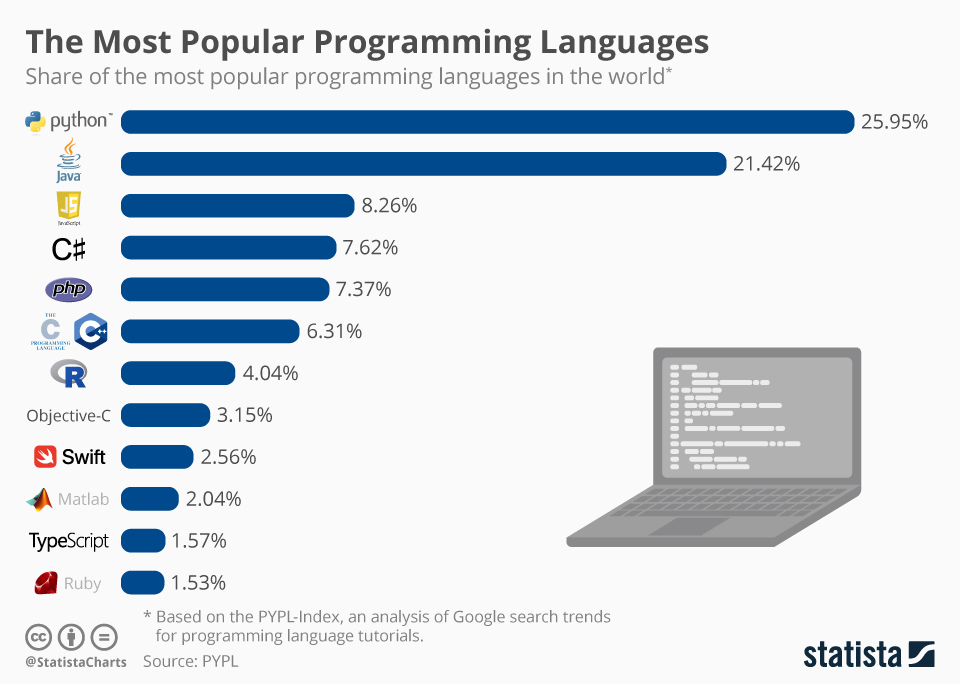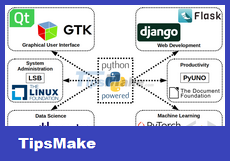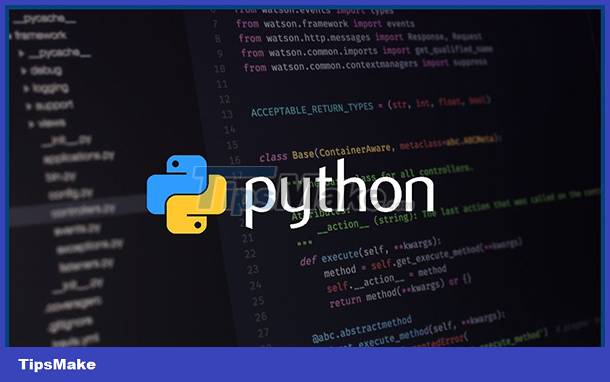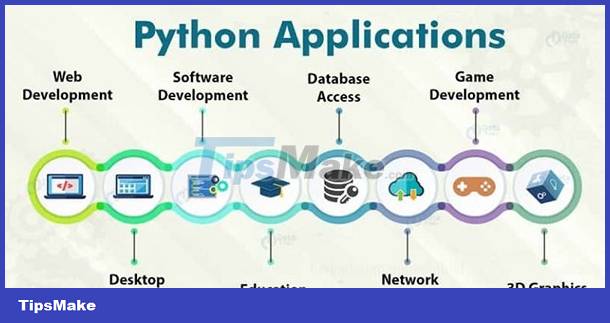What is Python? Why do programming learners need to know Python?
So what is Python and why does every programming student need to have knowledge of Python? Tipsmake provides detailed information in the article below.
What is Python programming language?
Python is a high-level programming language, widely used in web applications, software development, data science, and machine learning (ML). Programmers often use Python because it is efficient, easy to learn, and can run on many different platforms.
The advantage of Python is that it is an open source scripting language that anyone can download and use for free. This source code can be accessed and modified as per project requirements.
With its open nature and easy-to-use language system, Python is the most popular language in 2021 (ahead of Java and C).
Organizations using Python include: Google, Wikipedia, Yahoo!, CERN, NASA, Facebook, Amazon, Instagram, Spotify and ILM and ITA. The social news website Reddit is also written largely in Python.

Python language is used by many developers and computer programmers
History of formation and development of Python
Python was developed by Guido van Rossum at the National Research Institute for Mathematics and Computer Science in the Netherlands in the late 1980s. Mr. Rossum named this programming language after a television program, Monty Python's Flying Circus.

Python founder - Guido van Rossum
Python is considered the successor to the ABC language with the ability to handle and communicate exceptions. It is developed by other programming languages such as ABC, Modula 3, small talk, Algol-68. The telltale sign of a Python page is that it is a file with a .py extension containing possibly a combination of HTML Tags and Python scripts.
Python was created as a hobby by developer Guido van Rossum and Python shows its high usefulness so it has been developed into many versions with new and diverse features. Specifically:
- October 16, 2000, Python 2.0 was released.
- December 3, 2008, Python 3.0 was released with many tests, upgrading many new features.
Currently, Python expands and supports most other platforms such as Windows or MacOS.
What features does Python have?
Python is basically a programming language designed to be easy for learners to read, understand, and remember. Compared to other programming languages, we can use fewer lines of code to write a program in Python, creating a language that is concise, clearly structured, and convenient for beginners.
The Python language can be used for multi-paradigm programming, fully supports object-oriented programming, structural programming, and supports functional programming and aspect-oriented programming. Thanks to that, Python is often used in many different fields.
Specifically:
- Interpreted Language: Python is processed at runtime by the Python Interpreter.
- Object-oriented language: It supports object-oriented programming features and techniques.
- Interactive programming language: Users can directly interact with the python interpreter to write programs.
- Easy-to-learn language: Python is easy to learn, especially for beginners.
- Simple Syntax: The formation of Python syntax is very simple and easy to understand, which also makes it popular.
- Easy to read: Python source code is clearly defined and visible to the eye.
- Portable: Python code can run on multiple hardware platforms with the same interface.
- Extensible: Users can add low-level modules to the Python interpreter.
- Can be improved: Python provides an improved structure to support large programs then shell-script.

These systems are powered by Python
Why do programming learners need to know Python?
Python has diverse features and is used in many areas of application development. Understanding and mastering the Python language will help programmers use it fluently and apply it in many different jobs, including:
Python language is used for web server development
Websites regularly have to interact with databases, communicate with other websites, and protect data as it travels over the network.
Programmers will use Python to program server-side code because the language provides many libraries that include pre-written code for complex backend functions. They also use a series of Python frameworks that provide all the necessary tools to build web applications faster and easier.
For example: Instead of having to program from scratch, developers can quickly create framework web applications based on Python. They can then test this web application using the framework's testing tools, without relying on external testing tools.

Python is a useful tool in web development
Automate using Python scripts
Programmers frequently use Python scripts to automate many everyday tasks such as:
- Remove duplicate words in text files
- Rename a large number of files at once
- Convert a file to another file type
- Send email
- Download content
- Perform basic log analysis
- Perform basic math calculations
- Search for errors in multiple files
Data science and machine learning
Data science extracts valuable information from data, and machine learning (ML) teaches computers to automatically learn from data and make accurate predictions. Data scientists use Python for the following data science tasks:
- Extract and select diverse features of data
- Data labeling assigns meaningful names to data
- Correct and remove inaccurate data, also known as data cleansing
- Find various statistics from the data
- Visualize data using charts and graphs.
In Python, there are many important libraries serving computer science such as: OpenCV for image processing and machine learning, Scipy and Numpys for mathematics, linear algebra, Pandas for data analysis, …
Application for software development
Developers often use the Python language for various software development and application tasks:
- Undertake software project management
- Develop software prototypes
- Track errors in the software's code
- Automatically build software
- Develop desktop applications using Graphical User Interface (GUI) libraries
- Evolve from simple text games to complex electronic games

The job of a Python programmer
- Automate software testing
Software testing is a necessary testing process to ensure that the software is error-free. This process also aims to compare whether the actual results from the software match the expected results.
Developers use Python unit testing frameworks such as Unittest, Robot, and PyUnit to test the functions they write.
Engineers can use the Python language to test a web application's user interface, various software components, and new features, etc.
Compare Python with a few other programming languages
Python's design philosophy lies in the maxim: 'there should be only one, and preferably only one, explicit way to do this'. Instead of integrating all features into the core, Python is designed to be easily extensible with modules, and the Python interpreter is also easily extensible.
Compared to independent speed, Python will be slower than Java or C, but if you need speed, you can convert those functions to extension modules written in C. The core of Python is always focused on syntax. simple, clean and will always contain only one clear solution to your problem.
Along with the open Python library system, this is also the point where Python is favored by many programmers.
Where do Python programmers get their code?
To avoid having to program from scratch, developers build Python libraries, containing many reusable functions. In total, there are more than 137,000 Python libraries available for various applications, including web development, data science, and machine learning (ML).
Popular Python libraries include:
Matplotlib
The Matplotlib library is often used in scientific applications. Developers use this system to display data in high-quality two- and three-dimensional (2D and 3D) graphics.
Programmers or designers can visualize data by displaying data as different charts or displaying multiple charts at the same time, and graphic details can be migrated across any platform. .
Pandas
Pandas is a Python library system that provides optimized and flexible data structures with a focus on time series and structured data, such as tables and groups. Python learners or programmers can use Pandas to read, write, merge, filter, and group data.
NumPy
NumPy is a popular library used by many people. NumPy allows developers to easily create and manage groups, manipulate logical shapes, and perform linear algebra operations. At the same time, this system supports integration with many languages such as C and C++.
Requests
Requests provide many useful functions needed for web development. You can use this library to send HTTP requests, add headers, add URL parameters, add data, and perform many other tasks when communicating with web applications.
OpenCV-Python
OpenCV-Python is a library that developers use to process images for computer vision applications. This library provides many functions for image processing tasks such as reading and writing images simultaneously, building 3D environments from 2D environments, and capturing and analyzing images from videos.
Keras
Keras is Python's deep neural network library with excellent support for data processing, visualization, and more. It has a modular structure that provides flexibility for Programming innovative applications.
As of September 2021, the Python Package Index (PyPI), the official repository for third-party Python software, contains more than 329,000 packages with a wide range of functionality, including:
- Mobile application
- Multimedia
- Internet
- Computational science
- System management
- Automation
- Data analysis
- Database
- Document
- Graphical user interface
- Image processing
- Machine learning
- Automated testing
- Text processing
- Network framework
- Web scraping
Basic steps to learn Python yourself
Steps to start learning Python yourself, including:
- To make a website: learn frameworks like Django or Flask.
- To become a Data Analyst: learn about Python's available data analysis libraries. Next, start with small projects to be able to train the syntax, concepts, and basic commands of Python. This is an important starting step to get acquainted with Python.
- Solving programming problems with small projects helps learners grasp basic knowledge and move on to implementing larger projects.
- Focus on learning libraries and modules in Python. Grasping and understanding the functions in a library is a must for you to be able to use Python fluently.
Above is the information you need to know about the Python programming language. This is the basic computer language for those who are planning to become programmers. Hope you soon become familiar and proficient in using the Python programming language!
You should read it
May be interested
- Programming blockchain part 3: Python programming language
 guido van rossum, a dutch programmer, created python in 1991. python is based on a simple philosophy: minimalist. one of the interesting things about python is that it combines simplicity into a programming language by using spaces to denote code blocks instead of curly braces or keywords.
guido van rossum, a dutch programmer, created python in 1991. python is based on a simple philosophy: minimalist. one of the interesting things about python is that it combines simplicity into a programming language by using spaces to denote code blocks instead of curly braces or keywords. - Python - Powerful and intuitive programming language
 python is a free programming language developed by the python software foundation for computers. this open source tool is a programming language that can be used to develop and create various programs.
python is a free programming language developed by the python software foundation for computers. this open source tool is a programming language that can be used to develop and create various programs. - If, if ... else, if ... elif ... else commands in Python
 the if statement in python is one of the most common and easy-to-learn commands. apart from if there is if else, if elif else. let's explore the details and see examples of these if commands.
the if statement in python is one of the most common and easy-to-learn commands. apart from if there is if else, if elif else. let's explore the details and see examples of these if commands. - Multiple choice quiz about Python - Part 8
 python's built-in function of multiple-choice questions helps you update and review useful knowledge for your work and learn your python programming language.
python's built-in function of multiple-choice questions helps you update and review useful knowledge for your work and learn your python programming language. - Python data type: string, number, list, tuple, set and dictionary
 in this section, you'll learn how to use python as a computer, grasp python's data types and take the first step towards python programming.
in this section, you'll learn how to use python as a computer, grasp python's data types and take the first step towards python programming. - Multiple choice quiz about Python - Part 5
 if you are interested in learning about the python programming language, the following quiz of network administrator will provide useful knowledge for your learning.
if you are interested in learning about the python programming language, the following quiz of network administrator will provide useful knowledge for your learning. - 10 interesting facts about Python programming language
 there are many interesting things about python that you should know if you are learning about this programming language. some of them can be very helpful for you.
there are many interesting things about python that you should know if you are learning about this programming language. some of them can be very helpful for you. - Multiple choice quiz about Python - Part 4
 continue python's thematic quiz, part 4 goes back to the topic core data type - standard data types in python. let's try with quantrimang to try the 10 questions below.
continue python's thematic quiz, part 4 goes back to the topic core data type - standard data types in python. let's try with quantrimang to try the 10 questions below. - Multiple choice quiz about Python - Part 7
 following the previous test set, part 7 continues with the topic built-in functions in python. let's try with quantrimang to try the 10 questions below.
following the previous test set, part 7 continues with the topic built-in functions in python. let's try with quantrimang to try the 10 questions below. - Multiple choice quiz about Python - Part 10
 following the previous test, part 10 returned with the python function. let's try with quantrimang to try the 10 questions below.
following the previous test, part 10 returned with the python function. let's try with quantrimang to try the 10 questions below.










 3 ways to end a program in Python
3 ways to end a program in Python How to Install Python Packages in Raspberry Pi OS Bookworm
How to Install Python Packages in Raspberry Pi OS Bookworm How to connect and use PostgreSQL in Python
How to connect and use PostgreSQL in Python How to seamlessly integrate Python into Excel using PyXLL
How to seamlessly integrate Python into Excel using PyXLL Write a program to reverse a string in Python
Write a program to reverse a string in Python Write an alarm clock program in Python
Write an alarm clock program in Python